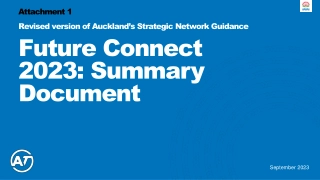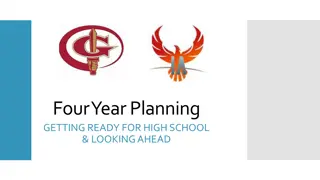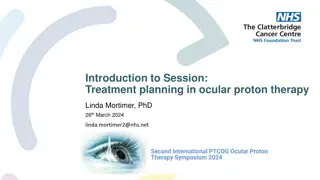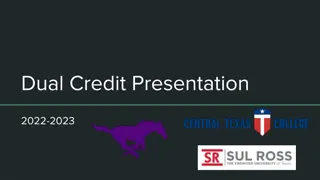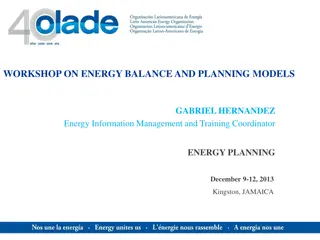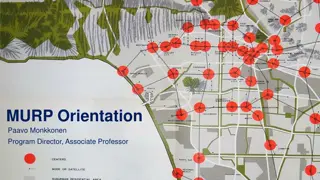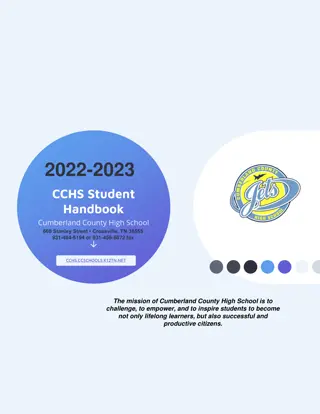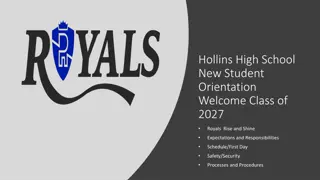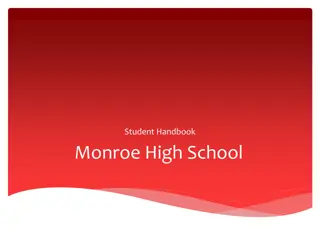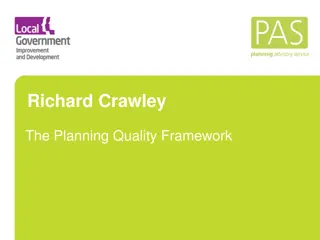High School Planning for Future Opportunities
Parent University stresses the importance of planning ahead for high school students to seize opportunities. The provided resources offer guidance on yearly checklists, scholarship preparation, university considerations, and Advanced Placement vs. Concurrent Enrollment options. Stay organized and informed to prepare for a successful academic journey.
Download Presentation

Please find below an Image/Link to download the presentation.
The content on the website is provided AS IS for your information and personal use only. It may not be sold, licensed, or shared on other websites without obtaining consent from the author.If you encounter any issues during the download, it is possible that the publisher has removed the file from their server.
You are allowed to download the files provided on this website for personal or commercial use, subject to the condition that they are used lawfully. All files are the property of their respective owners.
The content on the website is provided AS IS for your information and personal use only. It may not be sold, licensed, or shared on other websites without obtaining consent from the author.
E N D
Presentation Transcript
Parent University: High School Planning Planning ahead is key to not missing out on opportunities
Timeline Checklist: What should they be doing each year?
Preparing for Scholarships: What do they need to be doing now? Start a folder NOW: Academic Achievement Leadership Experiences Community Service Extra-Curricular Activities Types of Scholarships awarded based on merit: Academic Achievements Talent Leadership Departmental Ambassador Longevity in an area is more impressive than being a part of many things for short periods of time.
Student 4-Year Plan Things to think about: Do I want to go to the University of Utah? (2 year language requirement for admissions) Am I going for the Regents Scholarship? Do I want to play sports in college? NCAA requirements Do I want to go out-of-state? If yes, what are the admissions requirements of the out-of-state schools? (i.e. CA schools require full-year art credit, most out-of- state schools have 2-3 year language requirement)
Advanced Placement vs. Concurrent Enrollment Advanced Placement (AP) Concurrent Enrollment (CE) Must pass the test in May with a score of 3, 4 or 5. Most classes are through Weber State University The university the student goes to determines how the credit is counted. Have a GPA of 3.0 Apply for admissions AP Scores are added to the bottom of the high school transcript. Some universities will still have you send a score report directly from College Board to the university. Register for classes Cost is $5 per credit hour ($15) vs. $981 (HUGE TUITION SAVINGS) There is a 3 to 1 credit ratio on high school transcripts (i.e. a 3 credit hour college class = 1 full high school credit) BYU prefers AP credit but has higher requirements to earn the general education waivers. They like the rigor. At 12 CE credits, WSU awards the Edge Scholarship ($1,500 must have a 3.0 WSU GPA) Cost $94 this year. Most tests earn the student 6 college credits Most classes taken junior and senior year Course/Credit Replacement index on university websites Sophomores: Auto, Intro to Engineering, Interior Design 2, Advanced foreign language BHS Counseling Page Link:
BHS and WXHS CE Courses at BHS AP/IB Courses at BHS CE Courses at WXHS AP Courses at WXHS Auto 1, 2, 3 AP Studio Art Art History AP Art History IB Visual Art ASL Level 2 Computer Tech II AP English Design & Visual Art Auto 1, 2, 3 AP/IB Art History AP US History Cabinetry English 1010, 2010 AP Literature AP World History French AP Composition Chemistry/Chemistry Lab AP Psychology Exercise/Sports Medicine AP/IB French Communications AP Biology Bolded courses receive general education credit towards college degree. AP/IB Spanish Construction Math 1010/1030/1050 (23) AP Chemistry Medical Anatomy IB Dance Digital Media II AP Physics 1, 2 Advanced Marketing II Intro to Engineering Design AP/IB Math Courses (Calculus, Statistics) AP Calculus AB & BC Spanish 1010, 2010 Intro to Education AP/IB Biology AP Statistics Travel & Tourism IB Chemistry English 1010, 2010 AP Studio Art Entrepreneurship U. S. History 1700 AP/IB History Courses AP Music Theory IB Theory of Knowledge Intro to EMS AP Spanish AP/IB Research Medical Anatomy & Physiology Other CE/AP classes may satisfy certain requirements within a major or elective credit towards hours for the degree. Interior Design 2 AP/IB Psychology AP/IB Music Math College Algebra/Pre-calculus 1050/1060 IB German Music Appreciation IB Theater Computer Tech II A+ PC Maintenance AP Physics Advance Web Design AP Government Foundations of Nutrition Advanced Marketing II Woodworking/Millwork
International Baccalaureate Program (IB) at BHS Take a rigorous schedule sophomore year. Meet as many of the graduation requirements as possible in the non-core areas. Begins junior year in high school Core areas If you complete the FULL program you can graduate high school with your Associate Degree. You can also earn a certificate in certain subjects: English, Foreign Language, History, Science, Math, and the Arts. You complete tests in May for various subject areas to earn credit. REGISTRATION FEE: $168.00 This fee is paid only once by diploma students. Certificate students are required to pay the registration fee every year they test. TESTING FEE: $116.00 per exam. An IB certificate would, therefore, cost a total of $274.00. An IB diploma (with six exams) would total $864.00. The average IB student receives forty-four college credit hours. Many receive more credit-- depending on the college's policies. Forty-four hours comes out to approximately $20.00 per credit hour. That's much less than tuition + fees + books at any college. Website-http://www.davis.k12.ut.us/Page/38239 IB vs. AP? Harvard admissions says they value them equally.
Why would my student want Early College? #1 Consideration as you make this decision (in my opinion ): SOCIAL How do I get started in Early College? Step 1: Attend an Information Session Step 2: Complete the Application Process Step 3: Contact your High School Counselor (Must fill out a form to coordinate graduation from high school) Step 4: Meet with your Early College Advisor (DSD: Candy Busby, 801-395-3535) Go over high school requirements and college general education requirements. Step 5: Apply for Scholarships (tuition required) There is money reserved for high school students same criteria as in-coming freshman. Step 6: Attend New Student Orientation Is my child enjoying high school? Is my child ready to move forward with their life plans? Is my child tired of the people they have gone to school with forever? Note: College math expires after 2 years. Must take a placement test after that.
Other Considerations Centennial Scholarship (in state) Graduate early (1 year - $1,000, 3 terms- $750, 1 semester - $500, 1 term - $250) New Century Scholarship (in state) Associates Degree at the same time as the high school diploma (75% of tuition for junior/senior years) At 30 credits, students are not considered in-coming freshman. They are not eligible fore in-coming freshman scholarships. (CE credit only/not AP)
WSU Letter of Completion (LOC) A letter from WSU stating all General Education requirements are fulfilled The LOC can be presented to any State University or College and their GE requirements are waived, even if they are different. Approximately 39 college credits from both AP an CE classes can be earned
What is the LOC? English Composition (English 1010 and 2010) Math (Math 1050) Required coursework in these areas. Humanities/Creative Arts (9 credits) American Institutions (3 credits) Diversity (3 credits) Students can complete the requirements through AP and CE, grades 9-12 Physical/Life Science (9 credits) Social Science (6 credits) Information Literacy (1 credit)
ACT/CE Information ACT Averages High School CE Course Requirements: English 1010 English/Reading Score=21 Math 1050 Math Score=23 National=20.8 Utah=20.2 BHS=22.4 WXHS=21.4
Index Number: Used for Admissions and Academic Scholarships Many institutional scholarships and admissions are determined by a combination of a student s grade point average and ACT or SAT score. This is referred to as an index score. Students determine index scores with this chart. BYU and U of U are holistic. The others are straight index number.
Examples: BYU 131 U of U 128 USU - 115
Admissions Index & Scholarship Index INSTITUTION ACADEMIC SCHOLARSHIP INDEX ADMISSION INDEX SCHOLARSHIP PRIORITY/FINAL DEADLINE Brigham Young University Holistic (131 minimum*) Average of 124 Dec. 1/Feb. 1 BYU Idaho Varies, top 20% Average of 110 February 1 Utah State - Eastern 90 minimum Open enrollment March 1 Not index based (Own scale) Dixie State College Open enrollment March 1 LDS Business College Varies Open enrollment March 1 Salt Lake Community Varies Open enrollment March 1 Snow College 100 minimum Open enrollment March 1 Southern Utah University 105 minimum 90 Dec. 1/Feb. 1 University of Utah Holistic - (128 minimum*) 96 Dec. 1/Feb. 1 90 (17 ACT min/2.6 GPA min) Utah State University 115 minimum Dec. 1/Mar. 1 Utah Valley University 113 minimum Open enrollment Feb. 1/Aug. 15 Weber State University 105 minimum Open enrollment Jan. 10/Feb. 11 Westminster College Varies Rolling enrollment Dec. 1/Feb. 15


